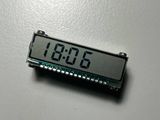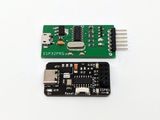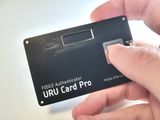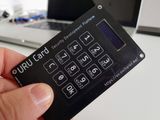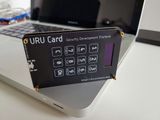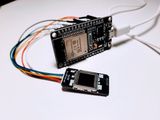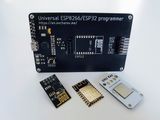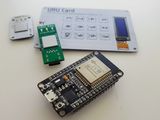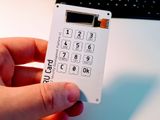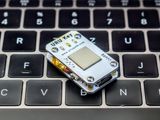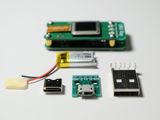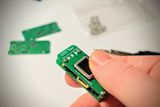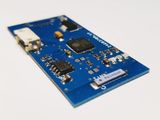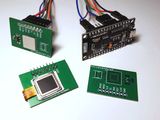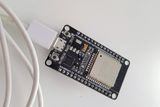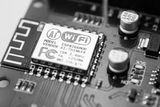Posts tagged with “esp32”
CH340G programmer for ESP8266/ESP32 - updated version
So, I have returned to my last year’s design of the CH340G based programmer and upgraded it with the same pinout as the widely known ESP01 module for the better compatibility and the USB Type C receptacle. Nowadays connectors of this type are way more popular than outdated Micro USB ones.
URU Card devices for sale
A lot of people asked if they can buy the URU Card—so I built one more, opened a little Tindie store, and… it sold out instantly. I’ll build more in small batches, so if you’re interested, just hit the watchlist and let me know your PCB color preference. No Kickstarter (yet), just a hobby!
The new form factor for the URU Key FIDO2 Authenticator
While working on the URU Card project, I realized just how practical the credit card form factor really is—so I redesigned URU Key into URU Card Pro. It now fits in a wallet, runs on an ultra-thin Li-Ion battery, and includes a tiny OLED display for feedback. Same secure guts, much better usability!
Using MPR121 touch keyboard controller with Arduino
I added a tiny capacitive touch keyboard to the URU Card using the MPR121 chip—and it works great! The PCB has 12 touch pads, the setup is dead simple with I2C and the Adafruit library, and best of all… no debouncing needed. Smooth and responsive UI, just like I hoped.
URU Card - the new PCB design
Got a fresh batch of URU Card PCBs, and this time I used them to build a full hard shell case—just by stacking boards together. No 3D printing needed! I also switched to a PCB antenna (zero cost!) and prepped the layout for a future USB interface with the FT260 chip. It’s compact, wallet-friendly, and fully functional.
How to use FPC1020A Capacitive Fingerprint Identification Module with Arduino
Picked up one of those common UART fingerprint modules? I did too. Turns out, it’s not just a scanner—it does internal matching with an onboard STM32 chip. I tested it with an ESP32 board, wrote up a simple Arduino sketch, and it works surprisingly well. Full pinout, usage, and code included!
Universal ESP8266/ESP32 programmer
I finally built myself a universal programmer for ESP8266 and ESP32 boards using a CP2102 chip and a bunch of connectors. It’s simple, cheap, and works with everything—from ESP-01 to my custom URU Card. Full schematic, photos, and files are in the repo if you want to build one too.
URU Card - minimal FIDO2 implementation with Arduino
Finally, a working BLE-based FIDO2 authenticator on Arduino! The URU Card project now supports basic credential creation and authentication via ESP32. Still early-stage (with hardcoded keys for now), but it’s enough to pass WebAuthn tests in Windows—and it’s open for everyone to try and build on.
URU Card - Arduino FIDO2 Authenticator
After a lot of requests to open-source URU Key, I’m starting a new project—URU Card! It’s a wallet-sized, open-source FIDO2 authenticator with an OLED screen, touch keyboard, and ESP32 brain. No biometrics (for now), but secure, DIY-friendly, and easy to build with Arduino libraries. Want to join in?
Latest news, URU Key project status and new project
It’s been a while since the last URU Key update, but the project’s still alive and kicking! Chrome dropped BLE support (ouch), but Windows still plays nice. Plus, I got official docs from Fingerprint Cards (🎉), and even tested URU Key with Windows Hello. Oh—and a new open-source project is coming soon!
URU Key - final hardware design
Hardware is done! After months of prototyping, I finally finished the compact 40×15mm URU Key device—complete with ESP32, fingerprint scanner, security chip, LiPo battery, and USB-C. It’s basically a fitness tracker… but for secure authentication. Now onto the software (and maybe a proper case 😅).
URU Key - fully autonomous prototype
It’s official—URU Key is now a real, standalone device! I added the custom power board, used spring-loaded pins for easy firmware updates, and screwed everything together into a compact 35×20×10mm unit. Hardware’s basically done—now it’s time to dive deeper into the firmware, especially the biometric side.
How to measure battery level with ESP32 microcontroller
Figured out how to measure battery level on the URU Key using a simple voltage divider and some clever GPIO control. Threw in some ESP32 ADC math to convert readings into a nice 0–100% percentage—and even blink a red LED if the battery’s running low. BLE support coming too!
URU Key - making decision on power source
Next step: power! I explored both CR2032 coin cells and tiny rechargeable LiPo batteries for the URU Auth device. Settled on a rechargeable setup with a TP4054 charger and USB-C—compact, convenient, and way more user-friendly. Bonus: added battery level monitoring and auto power-off to keep things efficient.
URU Key - an ESP32 FIDO2 Authenticator
Everything’s finally coming together! I combined the ESP32, fingerprint scanner, and ATECC508A security chip into a single board—the first real version of my own FIDO2 Authenticator: URU Auth (You Are You). It’s handheld, it lights up, and it’s so close to being fully autonomous. Time to tackle power and fingerprint recognition!
Using ATECC508A Cryptographic co-processor with ESP32
Time to tackle the ATECC508A crypto chip! I started building an ESP32 component library to use it in my FIDO2 Authenticator. One chip gave me trouble, but another worked perfectly. Lots of I2C fun, ECC signatures, and some helpful inspiration from SparkFun’s Arduino library. One step closer to full hardware-based security.
Progress in capturing raw fingerprint image with FPC1020A scanner
Getting actual fingerprint data out of the FPC1020A scanner was way harder than I expected. After days of digging and reverse-engineering Android kernel drivers, I finally got it to scan! Now I can detect fingers and capture raw images—next stop: matching algorithms.
FPC1020A* Fingerprint Scanners
Finally got my hands on the FPC1020 fingerprint scanners! These things are tiny, SPI-based, and perfect for a built-in solution. I built test boards, hooked them up to a NodeMCU, and wrote a basic Arduino sketch to read the hardware ID. Next step: integrating with the main authenticator project!
ESP32 Authenticator - first prototype design
Tried to go full DIY and desoldered the fingerprint sensor from the R300 module… but hit a wall—the pad layout doesn’t match any docs I could find 😕. So, switching gears: I’ve designed my own custom dev board for the authenticator with ESP32 Pico D4, ATECC508A, and room for a scanner. Boards are on the way!
WebAuthN on ESP32 development board
After getting FIDO2 working on Android, I gave it a go on the ESP32. Started with Arduino, but switched to ESP-IDF for more control. It’s super stripped-down—only one in-memory credential and a button for user presence—but it works! Got both registration and login running. Video inside!
CH340G programmer for ESP8266/ESP32
Slightly tired of big and long-running projects both at work and at home I decided to make a small spin-off project to help me working with ESP8266/ESP32 devices. Is there any reason to make it when there are a lot of cheap USB-Serial converters in the market? I don’t think so. My only reason to make it is to have cool addition allowing ESP8266s to be programmed automatically without flash/reset buttons but simple circuit with two transistors. Most of the USB to Serial converters simply do not have this circuitry on board. And, of course, I wanted to have some fun.
ESP32 implementation of FIDO2 Authenticator
Spent the weekend turning an ESP32 into a FIDO2 BLE Authenticator! Chrome even recognizes it (though it doesn’t do much yet). Also found a neat secure chip—ATECC508A—that could store encrypted keys. Still brainstorming how to handle more than 16 keys. Nerdy fun!
ESP8266 - simple configuration over WiFi
While building my CO2 sensor, I wanted to manage the device over WiFi—no buttons, no cables. So, I made a sleek web-based config panel using VueJS and Tailwind CSS, all running right on the ESP8266. Here’s how I replaced manual setup with a modern, async, file-based config system.
